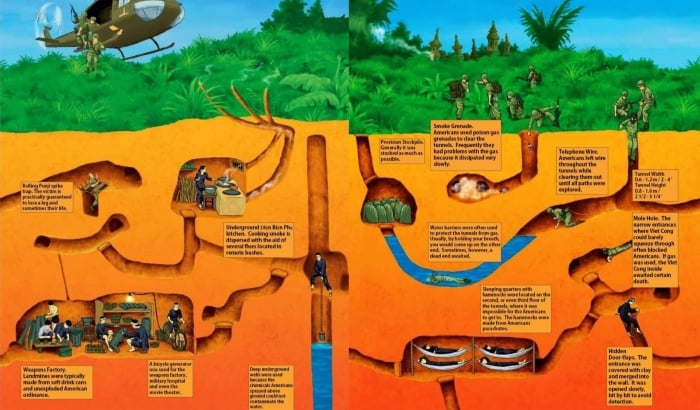Table of Contents
Nestled in the heart of Vietnam, amidst the lush green rice paddies and dense jungles, lies a network of underground tunnels that has become an iconic symbol of resilience and ingenuity. These are the Cu Chi Tunnels guide, a labyrinthine system of tunnels, bunkers, and hidden chambers that served as a crucial base for the Vietnamese resistance during the Vietnam War. Today, the Cu Chi Tunnels stand as a testament to the bravery and determination of the Vietnamese people, attracting visitors from around the world who come to explore this unique and fascinating historical site.
A Deeper Understanding of the Cu Chi Tunnels guide

The Cu Chi Tunnels were constructed by the Viet Cong, a guerrilla force that fought against the United States and its allies during the Vietnam War. The tunnels were initially dug as a network of supply routes, allowing the Viet Cong to move troops, weapons, and supplies undetected. Over time, the tunnels expanded, becoming a complex system of underground chambers and living quarters, complete with kitchens, hospitals, meeting rooms, and even a theater. The tunnels were built using simple tools and techniques. The Viet Cong used bamboo poles and thatch to reinforce the walls and roofs of the tunnels, creating a durable and well-ventilated structure.
The History of the Cu Chi Tunnels
The Cu Chi Tunnels guide have a long and rich history, dating back to the late 1940s when the Viet Minh, a communist revolutionary organization, began digging tunnels to evade French colonial forces. However, it was not until the 1960s, during the Vietnam War, that the tunnels were extensively expanded and utilized by the Viet Cong. The tunnels played a crucial role in the war, serving as a base for the Viet Cong’s operations and providing shelter and protection for their troops. The tunnels also served as a communication and supply network, allowing the Viet Cong to move freely and launch surprise attacks on their enemies.
The Construction of the Tunnels
The construction of the Cu Chi Tunnels was a massive undertaking that required immense planning, organization, and hard work. The tunnels were dug by hand, using simple tools such as shovels, hoes, and pickaxes. The Viet Cong worked tirelessly, often under the cover of darkness, to expand the tunnels and make them more complex and secure. They used different techniques to reinforce the walls and roofs of the tunnels, including bamboo poles, wooden beams, and layers of soil and clay. The tunnels were designed to be narrow and low, making it difficult for enemy soldiers to enter and navigate through them.
Life in the Tunnels
Life in the Cu Chi Tunnels guide was harsh and challenging, but the Viet Cong soldiers adapted and survived. The tunnels were cramped, dark, and infested with insects and vermin. The soldiers had to endure extreme heat, humidity, and lack of fresh air. However, they made the best of their situation, creating a functioning underground community. The tunnels were divided into different sections, with each section serving a specific purpose. There were living quarters, kitchens, hospitals, storage areas, and even a school and a theater. The soldiers also had to be constantly on guard against potential gas attacks from the enemy, so they built ventilation systems and gas traps to protect themselves.
Exploring the Cu Chi Tunnels Today
Today, the Cu Chi Tunnels have been preserved and turned into a popular tourist attraction, offering visitors a unique and immersive experience. The tunnels have been widened and reinforced to accommodate tourists, but they still retain their original structure and design. Visitors can explore different parts of the tunnels, crawl through narrow passageways, and even fire weapons used during the war. The site also features a museum, displaying artifacts and exhibits related to the Vietnam War and the Cu Chi Tunnels.
How to Get There
The Cu Chi Tunnels guide are located about 70 kilometers northwest of Ho Chi Minh City, making it a popular day trip for tourists. The most convenient way to get there is by booking a tour through a travel agency or hotel. These tours usually include transportation, entrance fees, and a guide who will provide information and insights about the tunnels. Alternatively, visitors can also take a bus or taxi from Ho Chi Minh City to the Cu Chi district and then hire a motorbike or bicycle to reach the tunnels.
What to Expect
Exploring the Cu Chi Tunnels can be an intense and physically demanding experience, so it is important to come prepared. Visitors should wear comfortable clothes and shoes that they don’t mind getting dirty. It is also advisable to bring a flashlight, as some parts of the tunnels can be quite dark. The tunnels can be narrow and claustrophobic, so those with mobility issues or a fear of enclosed spaces may find it challenging. However, there are alternative routes and exits available for those who do not wish to crawl through the tunnels.
Tips for Visiting
To make the most out of your visit to the Cu Chi Tunnels, here are some tips to keep in mind:
- Plan your visit in the morning or late afternoon to avoid the midday heat.
- Bring insect repellent to protect yourself from mosquitoes and other bugs.
- Wear sunscreen and a hat to protect yourself from the sun.
- Bring cash, as there are no ATMs or credit card facilities at the site.
- Respect the site and its history by not littering or damaging any structures.
- Listen to your guide and follow their instructions for a safe and enjoyable experience.
The Legacy of the Cu Chi Tunnels

The Cu Chi Tunnels guide have left a lasting impact on Vietnam’s history and culture. They have become a symbol of resilience, determination, and ingenuity, representing the unwavering spirit of the Vietnamese people. The tunnels also serve as a reminder of the atrocities and sacrifices made during the Vietnam War, and the importance of learning from the past to create a better future.
The Impact on the Local Community
The Cu Chi Tunnels have not only attracted tourists but have also brought economic benefits to the local community. Many families in the Cu Chi district rely on tourism for their livelihood, with some running homestays and restaurants for visitors. The tunnels have also created job opportunities for locals, with many working as tour guides or selling souvenirs at the site. Additionally, the tunnels have been used to educate younger generations about the country’s history and the struggles faced by their ancestors.
The Lessons Learned
The Cu Chi Tunnels have taught us valuable lessons about resilience, adaptability, and perseverance. Despite facing overwhelming odds, the Viet Cong soldiers were able to survive and thrive in the harsh conditions of the tunnels. Their resourcefulness and creativity in building and maintaining the tunnels are a testament to human resilience and the will to survive. The tunnels also serve as a reminder of the devastating effects of war and the importance of finding peaceful solutions to conflicts.
The Future of the Cu Chi Tunnels
As time passes, the Cu Chi Tunnels guide continue to attract visitors from all over the world, and efforts are being made to preserve and protect this historical site. In 2015, the tunnels were recognized as a National Historical Site by the Vietnamese government, ensuring its protection and conservation for future generations. The site is also being developed to include more interactive exhibits and activities, providing visitors with a deeper understanding of the tunnels and their significance.
Conclusion

The Cu Chi Tunnels guide are more than just a tourist attraction; they are a living testament to the resilience and determination of the Vietnamese people. They offer a unique and immersive experience, allowing visitors to step back in time and gain a deeper understanding of the country’s history. The tunnels have become a symbol of hope and perseverance, reminding us that even in the darkest of times, there is always a glimmer of light. So, if you ever find yourself in Vietnam, make sure to add the Cu Chi Tunnels to your itinerary for an unforgettable journey through history and resilience.